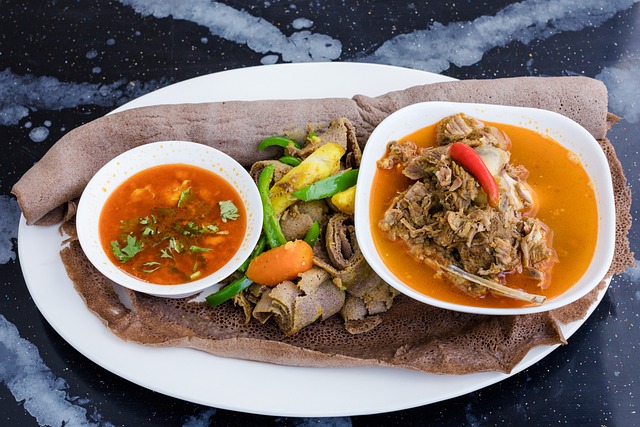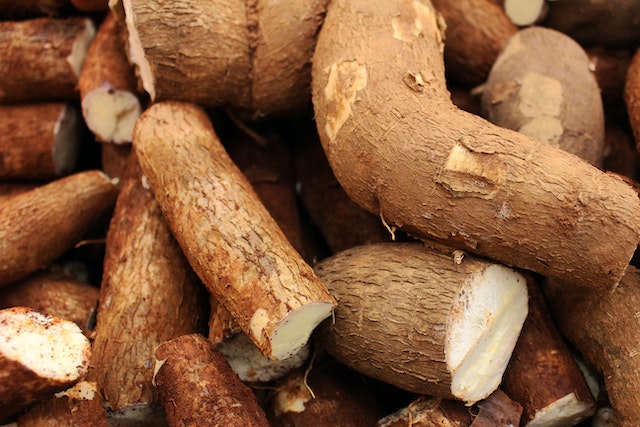
As one of the most diverse continents in the world, African cuisine is a testament to the richness of its culture, resources, and people. At the heart of African cuisine is a deep appreciation for traditional ingredients and cooking methods that have been passed down from generation to generation.
One of the most striking features of African cuisine is its diversity. From the spicy stews of Morocco to the savory peanut dishes of West Africa, the flavors and ingredients used in African cooking vary greatly from country to country. This diversity is due in part to the continent’s geography, which offers a wide range of climates and landscapes.
Traditional ingredients play a vital role in African cuisine, as they often have cultural and spiritual significance. For example, the yam, a type of tuber, is revered among the Igbo people of Nigeria and plays a central role in their cuisine. Other ingredients, such as the baobab fruit and the moringa plant, are used for their unique nutritional and medicinal properties.
Beyond its culinary pleasures, African cuisine is also an important part of cultural heritage. Food is often used in African traditions and rituals, such as the sharing of meals during festive occasions and the use of certain foods in spiritual ceremonies. Through cooking and eating traditional foods, African communities are able to preserve their cultural identity and pass it down to future generations.
Regional Flavors and Specialties
North Africa
North African cuisine is heavily influenced by the region’s history of Arab, Turkish, and Mediterranean trade, resulting in a blend of spices, vegetables, and grains. Some of the most notable dishes include:
Couscous: a grain-based side dish typically served with meat or vegetables
Tajine: a slow-cooked stew named after the earthenware pot it is cooked in, often featuring a mix of meat, vegetables, and aromatic spices
Shakshuka: a breakfast dish made with eggs poached in a tomato and pepper sauce
West Africa
West African cuisine features a wide range of spices, vegetables, and starches, with dishes often being quite spicy and pungent. Some of the most beloved West African dishes include:
Jollof rice: a spicy and fragrant rice dish often served with chicken or fish
Egusi soup: a hearty soup made with a type of melon seed and leafy greens

Fufu: a starchy side dish made from cassava, yams, or plantains, usually served with a sauce or soup
East Africa
East African cuisine is characterized by the use of aromatic spices and herbs, with dishes often featuring a mix of meats and vegetables. Some of the most well-known East African dishes include:
Pilau rice: a flavorful rice dish spiced with cinnamon, cardamom, and cloves
Injera: a spongy, fermented flatbread that is a staple in Ethiopian and Eritrean cuisine, often used as a utensil to scoop up stews and curries
Ugali: a simple and hearty side dish made from cornmeal that is often served with stew or vegetables
Southern Africa
Southern African cuisine is influenced by the region’s history of European colonization and indigenous ingredients. Some of the most popular dishes include:
Bobotie: a savory meat dish with a custard-like topping, often served with yellow rice and chutney
Biltong: a type of jerky made from spiced and dried meat, usually beef or game
Chakalaka: a spicy, vegetable-based relish often served with pap, a maize porridge
Notable African Ingredients
Grains and Tubers
The use of grains and tubers in African cuisine is vital to providing a source of starch and sustenance. Some notable grains and tubers in African cuisine include:
- Cassava: A starchy tuber used for making fufu and other starchy side dishes.
- Sorghum: A drought-resistant grain used for making porridges and beer.

- Millet: A staple grain in West and Central African cuisine, used in porridges, stews, and bread.
- Plantains: A type of banana that is boiled, fried, or mashed, and used in a variety of dishes.
Grains and tubers are often used as a base for stews and sauces, providing a thick and hearty texture to the dish. They are also important in African culture, representing strength, resilience, and endurance.
Proteins and Meats
Proteins and meats in African cuisine are varied and flavorful, with many unique options to choose from. Notable proteins and meats in African cuisine include:
- Goat: A common meat in East and West African cuisine, often used in stews and curries.
- Beef: A popular meat used in Southern African cuisine, often grilled or stewed.
- Fish: A staple protein in coastal and inland regions, often grilled or fried with spices.
- Chicken: A common meat used throughout Africa, often grilled, stewed, or served in rice dishes.
Meats are often slow-cooked or marinated before being added to stews, curries, or grilled dishes. They are often served with a variety of spices and sauces that add layers of flavor to the dish.
Vegetables and Legumes
Vegetables and legumes are a vital part of African cuisine, providing nutrients and flavor to meals. Notable vegetables and legumes in African cuisine include:
- Okra: A green vegetable used in stews and soups for its thickening properties.
- Cowpeas: A legume used in a variety of dishes, including stews and fritters.
- Amaranth: A leafy green used for its nutritional value in soups and stews.
- Pumpkin leaves: A leafy green used for its flavor and nutritional value in stews and soups.
Vegetables and legumes are often stewed or fried with spices and used as a side dish to accompany proteins and grains. They are also used in stews and soups to add flavor and nutrition.
Spices and Condiments
Spices and condiments are essential in adding depth and flavor to African cuisine. Notable spices and condiments in African cuisine include:
- Harissa: A North African spice blend made with chili peppers, garlic, and other spices used in stews, soups, and dips.
- Berbere: An Ethiopian spice blend made with chili peppers, ginger, and other spices used in stews and marinades.
- Peanuts: A common ingredient used in sauces and stews in West African cuisine.
- Sumac: A Middle Eastern spice used in North African cuisine for its tangy flavor.
Spices and condiments are often used to season proteins, grains, and vegetables. They can also be used as dips or sauces to add an extra layer of flavor to the meal.
Traditional Cooking Techniques in African Cuisine
African cuisine has evolved over thousands of years, and traditional cooking techniques have played a critical role in preserving the rich flavors and healthful qualities of the food. Some of the most distinctive cooking techniques used in African cuisine include:

Stewing and Slow Cooking
Stewing and slow cooking are popular techniques used in African cuisine to infuse flavor into meats and vegetables and to create tender, juicy dishes. Dishes are often cooked over low heat for hours to allow the flavors and aromas to meld together. One popular example of a slow-cooked African dish is the West African peanut stew, which is made with chicken, veggies, spices, and peanuts cooked slowly over low heat for several hours until the flavors are fully developed.
Grilling and Barbecuing
Grilling and barbecuing are other common cooking techniques used in African cuisine, especially in the Southern and Eastern regions. Grilling is a technique that involves cooking food over an open flame or hot coals, while barbecuing typically involves slow-cooking meat over low heat for several hours. Grilled and barbecued meats are often marinated in spicy rubs or marinades that add flavor and tenderize the meat. One popular African barbecue dish is the South African braai, which is a social event that involves cooking meat and vegetables over an open flame and sharing a meal with friends or family.
Fermentation and Preservation Methods
Fermentation and preservation methods, such as drying, smoking, and curing, have been used in African cuisine for centuries to preserve meats and vegetables for long periods without refrigeration. Fermentation is a process that involves the use of bacteria or yeast to break down sugars and produce acid, which helps to preserve food. One popular African fermented food is the Ethiopian sourdough bread, called injera, which is made by fermenting a batter of ground teff flour.
Use of Traditional Cooking Vessels
Traditional cooking vessels, such as clay pots, tagines, and calabashes, are still used in many African households to prepare food. These vessels are often made of natural materials and are designed to retain heat and cook food slowly. One example of a traditional African dish cooked in a clay pot is the West African stew, called maafe, which is made with meat, veggies, and peanuts stewed in a clay pot over low heat until the flavors are fully developed.
Fusion and Modern African Cuisine
In recent years, African cuisine has been gaining international recognition and popularity, with many contemporary chefs and restaurants promoting African cuisine and incorporating traditional ingredients in modern recipes. This fusion of traditional and modern cooking techniques has resulted in a range of African-inspired fusion dishes and culinary innovations that showcase the diversity and richness of African cuisine.
Contemporary Chefs and Restaurants Promoting African Cuisine
Contemporary African chefs and restaurants are showcasing the best of African cuisine to the world by combining traditional ingredients with modern cooking techniques, presenting dishes in new and innovative ways, and elevating African cuisine to new heights. Some of the most notable chefs and restaurants promoting African cuisine include:
Chef Pierre Thiam: The Senegalese-born chef has been instrumental in promoting African cuisine globally, with his New York-based restaurant, Teranga, which serves a range of African-inspired dishes using traditional ingredients in new and innovative ways.
The Test Kitchen, Cape Town: This award-winning restaurant in Cape Town, South Africa, is known for its fusion of traditional African ingredients and flavors with new, modern techniques.
Ikoyi, London: This Michelin-starred restaurant in London combines West African flavors with modern culinary techniques to create a unique and innovative dining experience.
African-Inspired Fusion Dishes
The fusion of African and Western culinary traditions has resulted in a range of African-inspired fusion dishes that showcase the best of both worlds. These dishes often incorporate traditional African ingredients such as yams, plantains, and spices, and combine them with familiar Western ingredients such as pasta, pizza, and burgers.
Examples of African-inspired fusion dishes include:
Jollof Rice Arancini: This fusion of the classic Italian rice balls with West African jollof rice features a crispy, golden crust filled with flavorful jollof rice.
Moroccan Spiced Lamb Pizza: A fusion of North African and Italian flavors, this pizza features a crispy crust topped with tender lamb marinated with Moroccan spices, roasted vegetables, and feta cheese.
Cape Malay Burger: This South African-inspired burger features a juicy beef patty topped with spicy tomato chutney, crispy onion rings, and a creamy yogurt sauce.

Culinary Innovations and Traditional Ingredients
Incorporating traditional ingredients in modern recipes is a hallmark of African fusion cuisine, and it has led to many innovative culinary creations. Chefs are experimenting with traditional ingredients such as millet, sorghum, and baobab fruit, and incorporating them into new dishes or using them in new ways.
Examples of culinary innovations in African cuisine include:
Millet Gnocchi: Traditionally made with potatoes, gnocchi is transformed by incorporating millet, a nutritious grain that is widely consumed in Africa. The result is a flavorful and unique take on a classic dish.
Sorghum Risotto: This twist on the traditional Italian risotto swaps out rice for sorghum, a gluten-free grain that is a staple in many African countries. The result is a creamy and flavorful dish that is both healthy and delicious.
Baobab Fruit Sorbet: The baobab fruit, which is native to Africa, is a rich source of vitamin C and other nutrients. Chefs are using this unique ingredient to create refreshing sorbets and other desserts that showcase the natural sweetness and tartness of the fruit.
African cuisine is a testament to the diversity and richness of African culture. It is a celebration of traditional ingredients, cooking techniques, and flavors that have been passed down from generation to generation. African cuisine not only satisfies our taste buds but also connects us to the heritage and history of the various communities within the continent. African cuisine is more than just food; it is a cultural experience, a celebration of diversity, and a connection to the African heritage.
